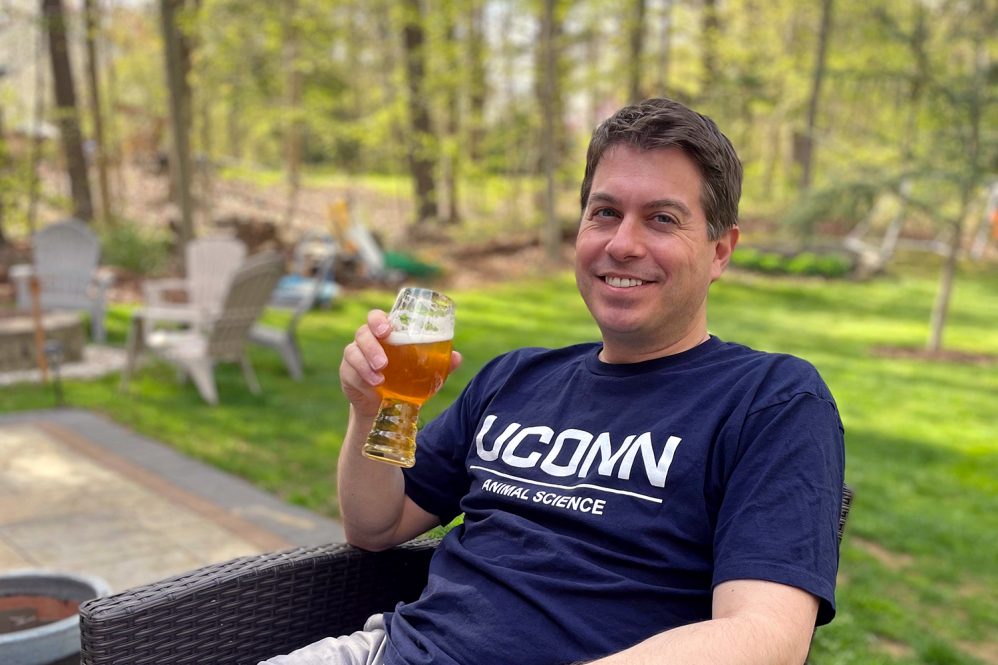Dennis D’Amico, associate professor of animal science in the College of Agriculture, Health and Natural Resources, has established his career as an expert in the science of cheese. But D’Amico also has a strong, and similarly scientific, passion for craft beer brewing.
D’Amico’s interest in craft brewing began while studying food science as an undergraduate at the University of Vermont (UVM) in the early 2000s. At the time, craft brewing was on the rise, especially in Vermont.
“I didn’t really like beer until I realized good beer existed,” D’Amico says. “[Craft beer] was around everywhere. So, I was exposed to some really interesting products early on.”
Many craft brews from outside the region were still not widely available and were more expensive than regular beers. These circumstances and his passion for food science and microbiology inspired D’Amico’s initial forays into home brewing.
“I started doing it in my apartment which was challenging because I didn’t have the space or money for the best equipment, so I kept it as basic as possible,” D’Amico says.
This interest quickly expanded as D’Amico learned more about the process.
“I just got so caught up in the history, the science, the exploration of trying all this stuff, and it just became this kind of enveloping obsession,” D’Amico says. “I even got a job at a small homebrew supply store, joined the local homebrewing club, and started participating in regional competitions.”
Following his research process, D’Amico would attempt to replicate beers he found at the store at home.
“Getting started is very easy,” D’Amico says. “All you really need is some hopped liquid malt extract, water, and yeast. My first batches were terrible in hindsight, but it was beer.”
To create different – and better – tasting beers, one selects various malted grains, hops, and yeast, which all contribute to different flavor profiles. It’s relatively easy for people to make great beer with little knowledge but there is a lot of art and science involved.
One way to develop sugars for brewing is by “mashing” or soaking grains in warm water. This process activates enzymes that convert starches in the grains to fermentable and unfermentable sugars and pulls out flavors and colors, D’Amico explains.
The mixture of grains plays a critical role in the beer’s final flavor and color, providing notes of bread, crackers, chocolate, caramel, coffee, and many more. Adjusting the time, temperature, and water chemistry of the mash also has an impact.
The resulting sweet liquid called “wort” is then boiled and hops are added at different points in the brewing process to impart bitterness and different flavor profiles, ranging from earthy to floral to fruity and beyond.
Once the wort is cooled, the yeast converts the sugar to alcohol and carbon dioxide while also producing flavor compounds depending on the strain and fermentation conditions.
D’Amico stayed at UVM for graduate school where his interest in brewing science continued. He helped develop and teach a general education class on the science of craft brewing. At the same time, UVM was starting a hops research program, making it a natural tie-in.
Similarly, UConn is launching its own hops research program through the Brewing Innovation Initiative which launched last semester. D’Amico hopes to use his experiences at UVM to establish similar courses at UConn, as brewing spans the agricultural sciences.
After completing his MS in food science and technology, D’Amico says he nearly pursued his PhD focusing on brewing, but the job market at the time had few openings.
“The only jobs for PhD brewing scientists were with big, commercial brewers,” D’Amico. “And that was the last place I ever wanted to be.”
Instead, D’Amico focused on his “other passion,” dairy products, for his PhD. He is an internationally recognized expert in dairy science and microbiology. He works with local producers and UConn students to study and create everything from artisanal cheeses to unique ice cream sold at the UConn Dairy Bar.
So, for many years, dairy consumed D’Amico’s time, leaving less time for home brewing. But when D’Amico moved to Connecticut in 2013, he reinvested in the hobby.
There have been major advancements in home brewing including equipment, ingredients, and more advanced computer programs to help calculate the complex formulas that he used to do by hand to figure out how to use different ingredients and processes to achieve a specific flavor profile.
When the COVID-19 pandemic hit, D’Amico saw it as an opportunity to ramp up researching and brewing. And he hasn’t stopped since.
“For the past three, four years I’ve been right back where I was 20 years ago, with even more knowledge and better equipment” D’Amico says.
When D’Amico restarted the hobby, he revisited his old recipes.
“I opened up this treasure trove and found the ones I had fine-tuned over the years,” D’Amico says. “I went back to those as a starting point, and I used my new knowledge to try and revamp them while I dialed in the new equipment. Then I moved on to exploring all the new techniques, ingredients and styles that have emerged.”
Whether it’s cheese, ice cream, or beer, D’Amico’s unique approach to the science of food keeps his passion brewing.
This work relates to CAHNR’s Strategic Vision area focused on Ensuring a Vibrant and Sustainable Agricultural Industry and Food Supply.
Follow UConn CAHNR on social media.



